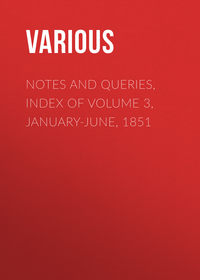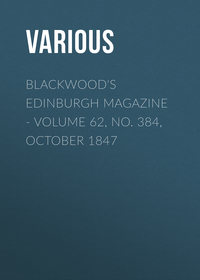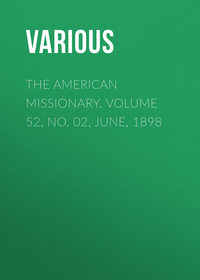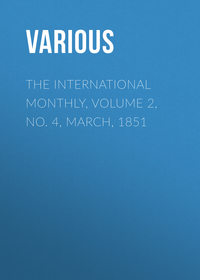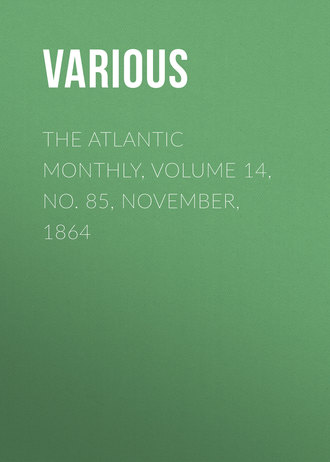 полная версия
полная версияThe Atlantic Monthly, Volume 14, No. 85, November, 1864
We seat ourselves in our comfortable arm-chairs, without the mortification of removing single gentlemen and the trouble of reversing seats to accommodate our party. The ladies are not compelled to sit in isolation, by the side of passengers who use the car-floor as a spittoon. We may chat together upon family-matters without awakening the vivid interest of any mother-in-Israel mounting guard in front of us over a bandbox. The gentlemen may smoke, if the ladies like it, and, so long as they keep the windows open, nobody shall say them nay. We all enjoy a sense of security and independence, which is like occupying a well-provisioned Gibraltar on wheels. If we have a sick friend with us, he need never leave his mattress till he reaches San Francisco. Should his situation become critical en route, the best medical attendance is at hand,—every through-train being obliged by statute to carry a first-class physician and surgeon, with a well-stocked apothecary-compartment. But our present party are all of them in fine health and spirits; so we may dismiss the doctor's shop from our consideration.
The whistle blows just as the ladies have hung their bonnets in the rack, and the gentlemen exchanged their boots for slippers. We wave adieu to the Atlantic coast and the friends who have come to see us off. A few minutes more, and we pass through the Bergen Tunnel. The remainder of the day is spent amid that wild mountain and forest scenery which the Erie Railroad has made familiar to the whole travelling-population of our Eastern States. At Salamanca we strike the Atlantic and Great Western's separate line. On the way thence to Dayton we shall pass a number of long trains, made up of platform-cars heavily laden with barrels carrying East the riches of the Pennsylvania oil-region. These have connected with our main road by a couple of branches built especially for the accommodation of the petroleum-trade. From Dayton to Cincinnati we shall traverse one of the finest farming-regions of the world, meeting trains laden with beeves, swine, packed pork, lard, grain, corn, potatoes, and every variety of produce that bears transportation. By this time, also, Ohio vine-culture has attained a development which justifies an occasional train entirely devoted to pipes of still Catawba and baskets of the sparkling brands.
From Cincinnati to St. Louis by way of Vincennes, we run through the southern portions of Indiana and Illinois, threading varied and picturesque scenery all the way, unless we have seen the Egyptian prairies so many times before that they pall on us before we reach the Mississippi bluff opposite St. Louis. Till we strike the prairie, our course is among bold, well-timbered hills, which now and then we are obliged to tunnel, and by the side of charming pastoral streams whose green bottom-land is shaded by noble plane-trees and cotton-woods. Certain passages in the scenery between Cincinnati and Vincennes are beautiful as a dream of fairy-land. Every few miles we continue to meet freight-trains laden with all the well-known products of the Western field and dairy. Twice, before we reach St. Louis, a splendid cortege of passenger-carriages shall whiz by us on the southern track,—and each time we shall have seen the daily through-express from San Francisco.
The St. Louis through-passengers will be ready, on our arrival, in cars of their own. We shall switch them on behind us with little over half-an-hour's detention, and strike for Leavenworth, taking Jefferson City by the way. The country we now traverse is rolling, well watered, and well timbered along the streams. Our road has so stimulated production in the mines of Missouri that we frequently pass on the switch a freight-train taking out bar and pig iron to San Francisco, or on the other track a train laden with copper ore going to the East for reduction. We have hitherto said nothing of the innumerable trains which pass us or switch out of our way, carrying through-freight between New York and San Francisco. We are still surrounded by excellent farming-land, a fine grain, fruit, and general-produce country. Not till we leave Leavenworth can we be said fairly to have entered the central wilds of the continent. We are now west of the Missouri River, and for a distance of two hundred miles farther shall traverse a country possessing certain individual characteristics which entitle it to a name of its own among the divisions of our physical geography. This is the proper place for an indication of those divisions, generalized to the broadest terms.
In passing from sea to sea, the American traveller crosses ten well-defined regions:—
1. The Atlantic slope of the Alleghany Range.
2. The eastern incline of the Mississippi basin.
3. The high divides of the short Missouri tributaries.
4. The Great Plains proper.
5. The Rocky-Mountain system of ridges and intramontane plateaus.
6. The Great Desert, broken by frequent uplifts, and divided by the Humboldt Range.
7. The Sierra-Nevada mountain-system.
8. The basin of the Sacramento River.
9. The mountain-system of the Coast Range.
10. The narrow Pacific slope.
By attending to these distinctions with map in hand we shall gain some adequate idea of the surface of our continent. The first and second of the regions we have left behind us, and at Leavenworth are well out upon the third. It would not be just to call it prairie,—and it is equally distinct from the true Plains. As a grain and grass land, Illinois nowhere rivals it; but its surface is remarkably different from that of the prairies east of the Mississippi. It may be described as an alternation of lofty bluffs and sinuous ravines,—the former known as "divides," the latter as "draws." The top of these divides preserves one general level,—leading naturally to the hypothesis that all the draws are valleys of erosion in a tract of alluvial deposit originally uniform with the plateaus of the divides. Some of the larger draws still serve as the channels of unfailing streams; most of them carry more or less water during the rainy season; few of them are dry all the year round. The river-bottoms which traverse this region are thickly fringed with cotton-wood and elm timber; but it is a rare thing to encounter trees on the top of a divide. The fertility of the soil is boundless. Every species of grass flourishes or may flourish here, with a luxuriance unrivalled on the continent. Of the tract embraced between the Little Blue and the Republican Fork of the Kaw this is especially true. The climate is so mild and uniform that cattle may be kept at pasture the whole year round. Haymaking and the building of barns are works of supererogation. The wild grass cures spontaneously on the ground. To provide shelter against exceptional cases of climatic rigor,—an unusual "cold snap," or a fall of snow which lies more than a day or two,—the ranchero constructs for his cattle a simple corral, or, at most, a rude shed. The utmost complication which can occur in his business is a stampede; and few of our Eastern farmers' boys would hesitate to exchange their scythes, hay-cutters, corn-shellers, and mash-tubs for the saddle of his spirited Indian pony and his three days' hunt after estrays. Over this entire region the cereals thrive splendidly. The wild plum is so abundant and delicious as to suggest the most favorable adaptation to the other stone-fruits. Every vegetable that has been tried in the loam of the river-bottoms succeeds perfectly. There is just reason to think that vine-culture might reach a development along the southern slope of the Republican Bluffs not surpassed in the most favorable positions east of California. We believe it no exaggeration to say that this region needs only culture (and that of the easiest kind) to become the garden of the continent. Its mineral wealth has received scanty examination; yet we know that it contains numerous beds of tertiary coal, and easily worked iron-deposits, in the form both of hydrated oxide and black scale.
On our way through this region we strike the Republican bottom near Lat. 39° 30' N., and Long. 97° 20' W. We are now in the primest part of the buffalo-pasture. As we wind along the base of the steep Republican Bluffs, and the edges of those green amphitheatres made by their alternate approach and retrocession, our whistle scares a picket-line of giant bulls, guarding a divide across the stream, and with tails in air, heads at the down charge, they scour away at a lumbering cow-gallop, to tell the main herd of a progress more resistless than their own. Or, perhaps, our experience of the buffaloes is a more inconvenient one. We may find the main herd crossing our track in their migration from the Republican to the Platte. In such case, there will be a detention of several hours, as the current of a main herd is not fordable by any known human mechanism. The halt will be taken advantage of by timid spectators looking safely out of car-windows,—by bonâ-fide hunters, who want fresh meat, and take along the tidbits of their game to be cooked for them at the next dinner-station,—and by excited pseudo-hunters, who will bang away with their rifles at the defenceless herd, until the ground flows with useless blood, and somebody suggests to them that they might as well call it sportsmanship to fire into a farmer's cow-yard, resting over the top-rail.
Now and then we shall whirl through a village of chattering prairie-dogs, send a hen-turkey rattling off her nest in a thicket on the river's edge, or perhaps surprise even an antelope sufficiently close to point out to the ladies from our window the exquisite flight of that swiftest and most beautiful creature in our American fauna. But our road will not be in running order very long before this sight becomes the rarest of the rare. The stolid buffalo will continue to wear his old paths long after the human presence has driven every antelope into invisible fastnesses.
At intervals along the Republican bottom we shall find ranches springing up under the auspices of our road; immense grain-fields yellowing toward harvest; great herds of domestic cattle grazing haunch-deep through the boundless swales of billowing wild grass; with all the other indications of a prosperous farming settlement, which, keeping pace with the progress of the road, shall eventually become one of the richest agricultural communities in the world, and continuous for over two hundred miles. Here and there we pass a lateral excavation in the face of the bluff where some enterprising settler has opened a tertiary coal-vein, a deposit of iron-ore, or a bed of soft limestone suitable for both flux and mortar purposes. The way-freight trains that meet us now are mainly laden with the wealth of the grazier, the farmer, and the gardener, competing with their brethren of the Upper Mississippi for the markets of St. Louis and New Orleans. Iron-ore, coal, and limestone may form a portion of the cargoes,—but in process of time the mutual vicinity of these minerals will become sufficiently suggestive to induce the erection of smelting-furnaces in situ, and then their combined product will travel the road in the form of pigs.
A little to the westward of a line drawn due south from Fort Kearney to the Republican we shall find a comparatively abrupt and unexplained change taking place in the scenery. Our green river-bottoms will give way to tracts of the color and seemingly of the sterility proper to an ash-heap. Our bluffs will recede, grow higher, and exchange their flat mesa-like surfaces for a curved contour, imitating the mountainous formation on a reduced scale. For long distances the vast gray level around us will be dotted with conical sand-dunes, forever piling up and tearing down as the wind shifts, with a tendency to bestow their gritty compliments in the eyes of passengers occupying windward seats on the train. The lovely blossoms of the running-poppy no longer mat the earth with blots of crimson fire; no more does the sweet breath of eglantine and sensitive-brier float in at the window as we whirl by a sheltered recess of the divides; the countless wild varieties of bean and pea no longer charm us with a rainbow prodigality of pink, blue, scarlet, purple, white, and magenta blossoms. The very trees by the river's brink become puny and stunted; the evergreens begin to replace the deciduous growths; in the shade of dwarfed and desiccated cedars we look vainly for the snowy or azure bells of the three-petalled campanula. Gaunt, staring sunflowers, and humbler compositæ of yellow tinge, stay with us a little longer than those darlings of our earlier scenery; but before we have gone many miles the last conspicuous wave of fresh vegetation breaks hopelessly on a thirsty sand-hill, and we are given over to a wilderness of cacti. Here and there occurs a sightly clump of waxen yellow blossoms, where these vegetable hedgehogs are in their holiday attire,—but it must be confessed that the view is a melancholy change from our recent affluence of beauty. With the other succulent plants, the rich herbage of the prairie has entirely disappeared. There is not a blade of anything which an Eastern grazier would recognize as grass between this boundary and the Rocky Mountains. As we whiz over these wastes at railroad-speed, we shall be apt to pronounce them absolutely sterile. When we stop at the next coaling-station, let us examine the matter more closely. The ground proves to be covered with minute gray spirals of herbage, like a crop of vegetable corkscrews, an inch or two in height, and to all appearance dry as wool. This is the "grama" or "buffalo-grass," and, despite its look of utter desiccation, is highly nutritious. It is almost the entire winter dependence of the buffalo-herds, and domestic cattle soon learn to prefer it to all other feed. Its existence, together with the wide group of changes which we have noticed, denotes that we have passed the threshold of the fourth grand continental division, and are now in the region of the Plains proper.
Ex-Governor Gilpin of Colorado, in his "Central Gold Region," very truly styles the Plains "the pastoral area of the continent." The Plains are set apart for grazing purposes by the method of exclusion. There is nothing else that can be done with them. Rain seldom falls on them. The shallow rivers, like the Platte, which wander through them, are too far apart to be used economically for their general irrigation. Only such herbage may be expected to thrive here as can live on its own condensation of water from a sensibly dry atmosphere. Manifestly, art can do nothing for the improvement of such a tract. It must be left to fulfil its natural function, as the great continental pasture. Along the banks of the rivers run narrow strips of alluvial soil, liable to yearly inundation; and these may be made amenable to the ordinary processes of agriculture. On these the herdsman may raise the grain and vegetables necessary for his own consumption. But the vast area of the region seems inevitably set apart for the one sole business of cattle-raising, and all the way-freight trains which pass us here are laden with beeves for the St. Louis market, or dairy-produce for all the markets of the world. We have never tasted grama-cheese, but have a theory that its individual piquancy must equal that of the delicious Schabzieger.
Far off on the gray level we shall still see the antelope. His tribe is coextensive with three-fourths of the continent. No sterility discourages him. He seems as thrifty on the wiry grama as among the most succulent grasses of the Republican. The sneaking coyote and a number of larger wolves put in an occasional appearance. Birds of the hawk and raven families are common. The waters swarm with numerous varieties of duck. It surprises us at this utmost distance from the maritime border to see flocks of Arctic gulls circling around the low sand-hills, and sickle-bill curlews wheeling high in air above their broods. Before we get far into this region we shall notice that one of its most typical features is the alkali-pool. Every few miles we come to a shallow basin of stagnant water saturated with salts of soda and potash. Still another characteristic of the Plains is their tremendous rainless thunder-storms. If we are fortunate enough to encounter one of these, we shall witness in one hour more atmospheric perturbation than has occurred within our whole previous experience on the Atlantic slope. The lightning for half a night will light the sky with an almost continuous glare, brighter than noonday; all the parks of artillery on earth could not make such a constant deafening roar as those iron clouds in the heaven; and though the wind will not be able to blow the train backward, as we have seen it treat a four-mule stage, it will be likely to do its next best thing, heaping sand on the track till the engine has to slow and send men ahead with shovels.
Entering the Denver depot, we shall find a busy scene. All that immense freight-business between the Missouri and the Colorado mining-towns, which formerly strung the overland road with wagons drawn by six yoke of oxen each, has now been transferred to the railroad. The switches are crowded with cars getting unloaded, or waiting their turn to be. What is their freight? Rather ask what it is not. For the present, Colorado imports everything except the most perishable commodities,—and that which pays for all. If you would see that, ask the express-messenger on the train going East in five minutes to lift the lid of one of those heavy iron trunks in his car. Your eyes are dazzled by the yellow gleam of a king's ransom. It is a day's harvest of ingots from the stamps of Central City, on its way to square accounts with New York for the contents of one of those freight-trains.
At Denver we reach the edge of the Rocky-Mountain foot-hills; the grand snow-peak of Mount Rosalie, rivalling Mont Blanc in height and majesty, though forty miles away, seems to rise just behind the town; thence southerly toward Pike's and northerly toward Long's Peak, the billowing ridges stretch away brown and bare, save where the climbing lines of sombre green mark their pine-fringed gorges, or the everlasting ice pencils their crests with an edge of opal. Still we do not leave the Plains region. We glide through the thronged streets of the growing city, cross the South Platte by a short bridge, and strike nearly due north along the edge of the mountain-range, over a broad plateau which still bears the characteristic grama. Not until we enter the cañon of the Cache-la-Poudre, a hundred miles from Denver by the road, can we consider ourselves fairly out of the Plains, and in the fifth great region of the continent, the Rocky-Mountain system of ridges and intramontane plateaus.
Before we begin this portion of our journey, let us examine, in the light of that already accomplished, an assertion made early in this article to the effect that the Pacific Railroad must precede and create the business which shall support it. The consideration shall be brief as a mathematical process.
The river-bottoms and divides along the Lower Republican are peculiarly suited to the raising of farm-produce. But so long as they had no avenue to a market, they might have been fertile as Paradise without alluring settlers to cultivate them. The natural advantages of a country are developed not as a matter of taste, but as a matter of profit. The crops which can be raised to best advantage in this region are the crops which without a railroad must rot on the ground. No man can be expected to settle in a new country from pure Quixotism,—and nothing but the railroad would make anything else of his expenditure of energies beyond the needs of self-support. The Plains are the natural pasture of the continent; but they have no natural fascination for the white man which can induce him to take up his residence there for cattle-breeding en amateur. The greatest enthusiast in butter and cheese would scarcely care to accumulate mountains of rancid firkins and boxes for the mere gratification of fancy. Access to a market is his only justification for spending a nomadic lifetime among herds, or a fortune on churns and presses. The settlement of the country must precede the birth of its industries, and the Pacific Road is the absolutely essential stimulus to such settlement.
As we converse, we are beginning our climb toward the snow. A series of steep grades, mainly following the bed of that wildly picturesque and roaring torrent, the Cache-la-Poudre, take us up through the Cheyenne Pass to the Laramie Plains. In reaching the head of the Cache-la-Poudre we have familiarized ourselves with the ridges of the system; we are now to learn what is meant by the intramontane plateaus. The Laramie Plains form the most remarkable plateau of the Rocky Range,—one of the most remarkable anywhere in the known world. Through a series of savage cañons we enter what appears to us a reproduction of the prairies east of the Mississippi,—a level and luxuriantly grassy plain, bright with unknown flowers, alive with startled antelope, threaded by the clear currents of both the Laramie Rivers, and rejoicing in an atmosphere which exhilarates like the fresh-brewed nectar of Olympus. Bounded on the east by the great ridge we have just passed, northerly by a continuation of the Wind-River Range and Laramie Peak, southerly by a magnificent transverse bar of naked mountains running parallel with the Wind-River Range, and westward by a staircase of sterile divides which we must climb to reach the base of Elk Mountain and find its giant mass towering into the eternal snows three thousand feet farther above our heads,—this plateau is a prairie fifty miles square, lifted bodily eight thousand feet into the air. It is difficult for us to roll over this Elysian mead walled in by these tremendous ranges, and think of the commercial uses to which the level might be put; but from its elevation and its natural crop we may pronounce it a grazing tract of splendid capabilities, unsuited to artificial culture.
Another series of grades takes us past the base of Elk Mountain to a broad and sandy cactus-plain, whence we descend among curious trap and sandstone formations, simulating human architecture, to the crossing of the North Platte. A little farther on, so close to the snow-line that we shiver under the white ridges with a reflected chill, we cross the axial ridge of the continent, and begin our descent toward Salt Lake by the noble gallery of Bridger's Pass. The springs along our way become tinctured with sulphur, alkali, and salt. We know, when we stop at a station to drink, that we are drawing near the primeval basin of a stagnant sea, now shrunk to its final pool in Salt Lake, but once in size a rival of the Mediterranean. We pass over an alternation of mountain-grades and sandy levels, cross the Green or Upper Colorado River, stop for five minutes at the Fort-Bridger station, thread the sinuous galleries of the Wahsatch, and come down from a savage wilderness of sage-brush, granite, and red sandstone, into the luxuriant green pastures of Mormondom, heavy with crops and irrigated from the snow-peaks. Thence, one of the numerous cañons—Emigrant or Parley's most likely—conducts us to the mountain-walled level of Salt-Lake City.
We have now traversed the most difficult part of our road. Its Rocky-Mountain section has cost more capital, labor, and engineering skill than all the rest together. The return for this vast expenditure must be no less vast,—but it will be rendered slowly. It does not lie on the surface or just beneath the surface, as in the pastoral and agricultural regions. It is almost entirely mineral, and must be mined by the hardest work. But it ranges through all the metallic wealth of Nature, from gold to iron, and no conceivable stimulus short of a Pacific Railroad could ever have been adequate to bring it forth.
We shall find the import trade of Salt Lake by the railroad to consist chiefly of emigrants and their chattels. If Brigham Young be still living, his favorite policy of non-intercourse with the Gentiles may also somewhat diminish the export business of the road. But human nature cannot forever resist the currents of commercial interest; and the Mormon settlements possess so many advantages for the economical production of certain staples, that we need not be surprised to find trains leaving Salt-Lake City with sorghum and cotton for San Francisco, and raw silk for all the markets of the East.
From Salt-Lake City to the Humboldt Mountains, we pass between isolated uplifts of trap and granite, over a comparatively level desert of sand and snowy alkali. The terrors of this journey, as performed by horse-carriage, have been fully depicted in our last April number. We may laugh at them now. The question which principally interests us, after we have blunted the first edge of our wonder at the sublime sterility of the Desert, is what conceivable use this waste can be made to subserve. Before the railroad, that question had but a single answer,—the inculcation of contentment, by contrast with the most disagreeable surroundings in which one might anywhere else be placed. Perhaps it is over-sanguine to conceive of a further answer even now. If there be any, it is this: In its crudest state the alkaline earth of the Desert is sufficiently pure to make violent effervesence with acids. No elaborate process is required to turn it into commercial soda and potash. Coal has been already found in Utah. Silex exists abundantly in all the Desert uplifts. Why should not the greatest glass-works in the world be reared along the Desert section of the Pacific Road? and why should not the entire market of the Pacific Coast be supplied with refined alkalies from the same tract? Given the completed railroad, and neither of these projects exceeds commercial possibility.



